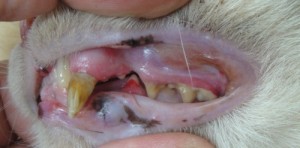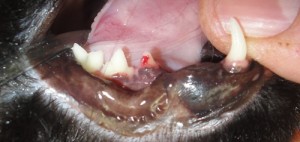Cats rarely get abscessed teeth that need removal like dogs. Instead, they have their own disease – feline resorptive lesions. The problem is that it goes undetected until it is too late and we have already lost the tooth. Let’s see what causes it and what we can do.
Tooth resorption occurs in an incredible number of cats. Estimates vary between 20% and 75% of cats. Many cats silently suffer from this painful disease and they are never diagnosed.
 The first thing you see is a bit of red gum at the bottom of the tooth. Any tooth can be affected, but the most common one is the tooth behind the big canine (eye) tooth on the lower jaw.
The first thing you see is a bit of red gum at the bottom of the tooth. Any tooth can be affected, but the most common one is the tooth behind the big canine (eye) tooth on the lower jaw.
That little bit of red gum is trying to cover a defect in the tooth enamel. By the time you see this, the inside of the tooth is already destroyed. Taking an x-ray, you can see a hole in the tooth telling you the tooth is lost.
When we detect the damaged tooth, the only treatment we have is to remove it and get rid of the pain from the irritated nerves. With the tooth removed, the gum is stitched and the cat is pain free.
If these teeth are left to decompose in the mouth, the cat is in continual pain. It does not stop them eating but it can reduce appetite, make them miserable, and they may drop food from that side of the mouth. Cats that are just grouchy may be suffering from sore teeth.
So what causes this condition? As it turns out, we do not know. Researchers have looked for a virus, and have examined food texture, food ingredients and even the source of water. Nothing has been proven.
This means we have no way to prevent it. The key is to be pro-active and spot these tooth problems so we can take the pain away.
Dr. Louise Janes D.V.M. & Dr. Jeff Grognet D.V.M
 Mid-Isle
Mid-Isle
Veterinary Hospital
5-161 Fern Road
West Qualicum Beach, BC
Tel (250) 752-8969
Website
Veterinary Assistant Learning Center
See all articles by Dr. Louise Janes D.V.M. & Dr. Jeff Grognet D.V.M.



